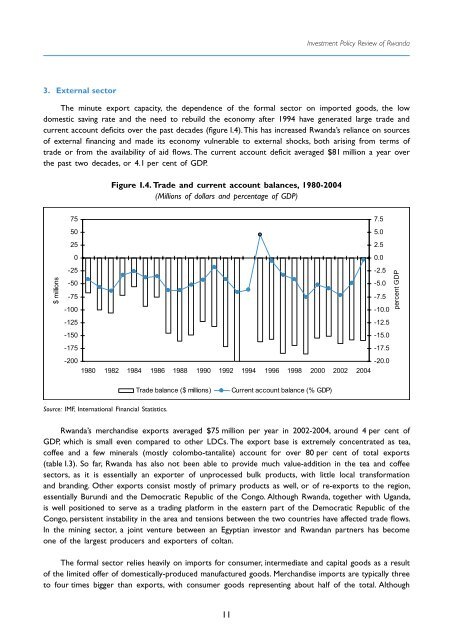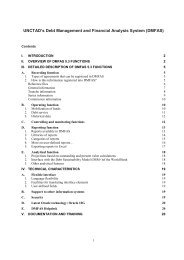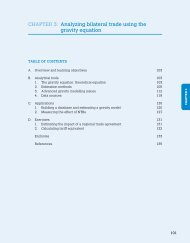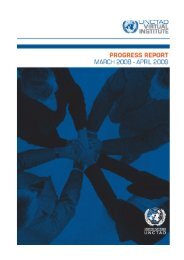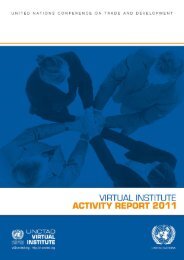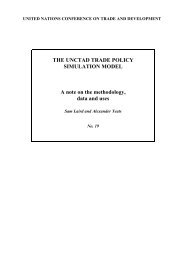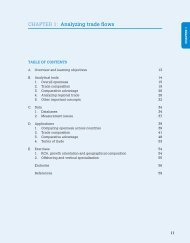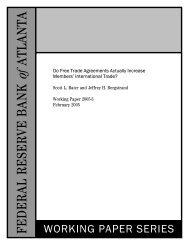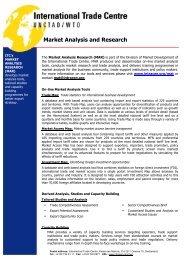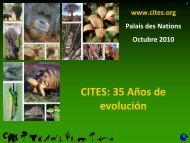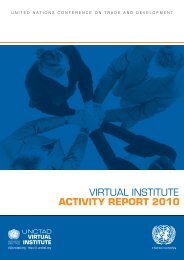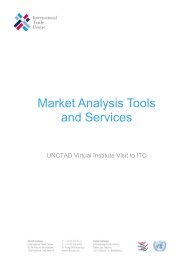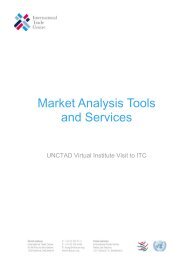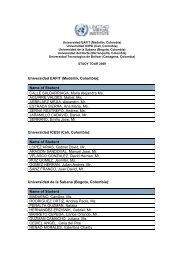Investment Policy Review - Rwanda - UNCTAD Virtual Institute
Investment Policy Review - Rwanda - UNCTAD Virtual Institute
Investment Policy Review - Rwanda - UNCTAD Virtual Institute
You also want an ePaper? Increase the reach of your titles
YUMPU automatically turns print PDFs into web optimized ePapers that Google loves.
<strong>Investment</strong> <strong>Policy</strong> <strong>Review</strong> of <strong>Rwanda</strong><br />
3. External sector<br />
The minute export capacity, the dependence of the formal sector on imported goods, the low<br />
domestic saving rate and the need to rebuild the economy after 1994 have generated large trade and<br />
current account deficits over the past decades (figure I.4). This has increased <strong>Rwanda</strong>’s reliance on sources<br />
of external financing and made its economy vulnerable to external shocks, both arising from terms of<br />
trade or from the availability of aid flows. The current account deficit averaged $81 million a year over<br />
the past two decades, or 4.1 per cent of GDP.<br />
Figure I.4. Trade and current account balances, 1980-2004<br />
(Millions of dollars and percentage of GDP)<br />
$ millions<br />
75<br />
50<br />
25<br />
0<br />
-25<br />
-50<br />
-75<br />
-100<br />
-125<br />
-150<br />
-175<br />
-200<br />
1980 1982 1984 1986 1988 1990 1992 1994 1996 1998 2000 2002 2004<br />
7.5<br />
5.0<br />
2.5<br />
0.0<br />
-2.5<br />
-5.0<br />
-7.5<br />
-10.0<br />
-12.5<br />
-15.0<br />
-17.5<br />
-20.0<br />
percent GDP<br />
Trade balance ($ millions)<br />
Current account balance (% GDP)<br />
Source: IMF, International Financial Statistics.<br />
<strong>Rwanda</strong>’s merchandise exports averaged $75 million per year in 2002-2004, around 4 per cent of<br />
GDP, which is small even compared to other LDCs. The export base is extremely concentrated as tea,<br />
coffee and a few minerals (mostly colombo-tantalite) account for over 80 per cent of total exports<br />
(table I.3). So far, <strong>Rwanda</strong> has also not been able to provide much value-addition in the tea and coffee<br />
sectors, as it is essentially an exporter of unprocessed bulk products, with little local transformation<br />
and branding. Other exports consist mostly of primary products as well, or of re-exports to the region,<br />
essentially Burundi and the Democratic Republic of the Congo. Although <strong>Rwanda</strong>, together with Uganda,<br />
is well positioned to serve as a trading platform in the eastern part of the Democratic Republic of the<br />
Congo, persistent instability in the area and tensions between the two countries have affected trade flows.<br />
In the mining sector, a joint venture between an Egyptian investor and <strong>Rwanda</strong>n partners has become<br />
one of the largest producers and exporters of coltan.<br />
The formal sector relies heavily on imports for consumer, intermediate and capital goods as a result<br />
of the limited offer of domestically-produced manufactured goods. Merchandise imports are typically three<br />
to four times bigger than exports, with consumer goods representing about half of the total. Although<br />
11


